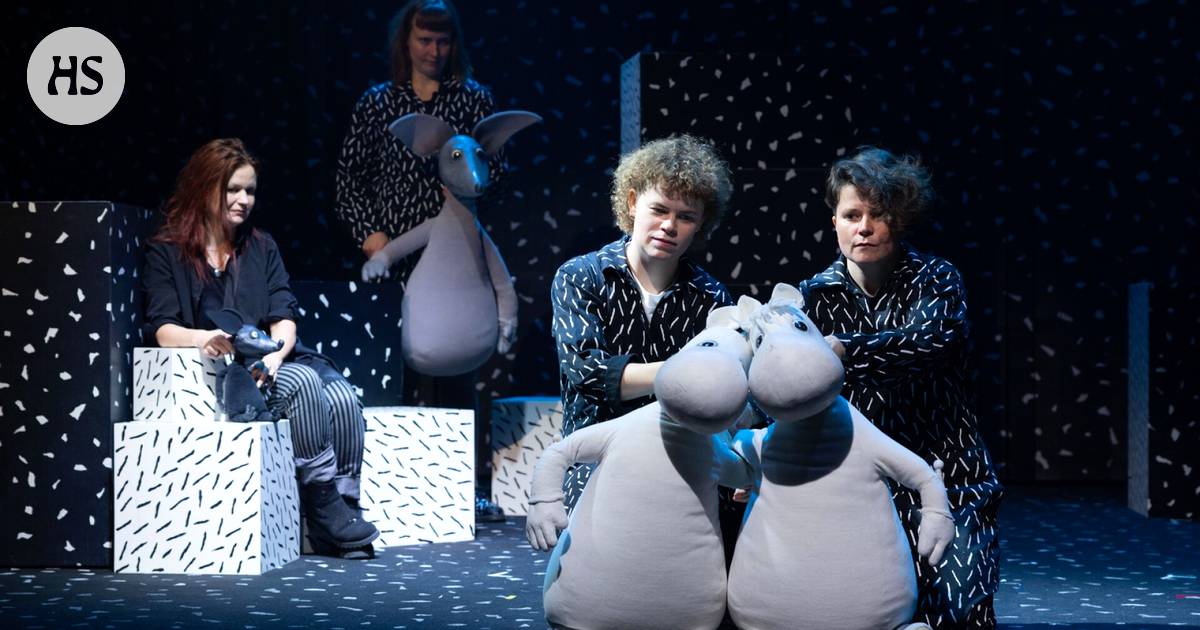There it now sits, Moomin, after 64 years on the stage of the Helsinki theater. It looks like a big stuffed animal, chubby inviting to hug.
Guess what its fluffy muzzle feels like? From rubber. Almost like a boxing glove.
Right now, Moomin isn’t in the mood to talk, but otherwise it’s full speed ahead this fall. And so are many others Tove Jansson’s by developing a fairy tale character, because Lilla Teatern’s Kris och katastrof i Moomindale -show marches on stage a hundred familiar characters from the Moomin world – as magically fascinating, expressive and strangely human dolls.
They are all designed by an award-winning puppeteer Heini Maaranen.
Maaranen says that he would not have joined this theater project without a director Jakob Höglund.
“I must have even said once that I wouldn’t touch Moomins, but because of Jakob, I agreed. Even if he suggests something crazy, it’s always interesting,” says Maaranen.
About a hundred figures is a huge number of dolls to make, even if the number includes even the tiniest of props. Usually Maaranen takes care of everything in her performances, from designing the puppets and props to building them, but now in the big house the responsibility has been shared.
“Although I’ve built a lot myself and especially kept the making of the faces and expressions in my own hands, dolls have been made both by a prop sewing shop and a stage workshop.”
“Jansson’s material is unimaginably vast and the world really rich, and it is controlled to some extent. It’s its own challenge to respect it and try to make something of your own,” says doll designer and doll builder Heini Maaranen with Moomin next to him.
Maaranen says that the design work was challenging in a positive way.
“Jansson’s material is unimaginably vast and the world really rich, and it is controlled to some extent. It’s its own challenge to respect it and try to make something of your own.”
Since there are so many puppets, it’s important not to build them all the same way. According to Maaranen, the whole becomes more interesting the more different puppet techniques you can utilize.
“I’ve been hoping to be able to play under the conditions of a puppet theater in different ways, and not just realize an image from some animation.”
The puppets in the show are of very different types, different sizes and can be moved with varying techniques – and extremely fascinating. The largest includes the three-meter Vilijonkka, which is puppeted by two people. One of them sits hidden inside the character’s body moving the arms and legs, the other moves the head and gives the character a voice.
A trinket is a large doll whose feet are the puppeteer’s feet. Dr. Schrünkel, on the other hand, has long, wild tentacled hands.
Two-dimensional cardboard figures are also seen on stage, and for example a bunch of tiny hairballs, i.e. ugly words.
at Lilla Teatern we last saw Moomins in 1958 on the show Troll i kuliserna. The musical theater show you can see now is based on Tove Jansson’s cartoons aimed at adults from 1954 to 1959, which were published in the British Evening News newspaper.
Moomin characters come alive on stage with small movements and gestures. It requires special skill and sensitivity. Some of the puppets are moved by Lillan’s actors, but there are also puppet theater professionals involved.
Professional puppeteers Elena Rekola, Riina Tikkanen and Reetta Moilanen roared on stage during practically the entire performance. Especially Tikkanen and Moilanen constantly change characters. Or they are part of a character’s body part, because some characters are dolled up by many people at the same time.
Reetta Moilasen has many roles in the show. One of them is Nuuskamuikkunen, which is born from the hat, the head of the puppeteer and the small body of the character.
“I am Stink and Snuff, Hemuli, fireworks, tree, bottle, Dr. Schrünkel’s right-hand man, I help Lady Niskune, Moomin, Moominpappa, Moominma, Little Myt…”, Moilanen enumerates.
“Sometimes I’m in mom’s left hand and someone else’s right hand at the same time.”
Tikkanen also does and helps as much as he can. His biggest roles are Nipsu and Vilijonkka, of which the latter in particular is the show’s showiest and funniest character.
The scene at the rave party, where Nipsu acts as a DJ, is also hilarious.
“Gone is the childishness created by the clunky Moomin costumes. Moomin philosophy takes over the stage as an expressive musical puppet theater,” writes HS’s critic in his review, and gives the show four stars.
Read more: The expressive Moomins make the Lilla Teatern’s stage swing like clockwork machinery
Elena Rekola and Riina Tikkanen introduce Vilijonkka behind the scenes of the show.
What kind of is to doll up the iconic, familiar Moomin characters?
“I wonder if the viewers will connect the sounds of the original animation with this show of ours at all. Our whisperer Ragni Grönblom did Niiskuneidi’s voice for the Swedish version, and I’ve been thinking about whether I can ‘redeem’ my role as Niiskuneidi, even if I do it in a different way than has been seen before,” says Rekola, who plays the character.
“These cartoon characters are really different compared to animation. It gives freedom in a completely different way. For example, Haisuli is more reckless and criminal than in TV animations,” says Moilanen, who plays the character.
“In a puppet theater, role-playing is done a little differently anyway. If a human actor were to make Nipsu, for example, that history would certainly have a very different ballast than a doll with a certain shape,” says Tikkanen.
According to Moilanen, half of the role-playing work is already done at the stage when the doll is built and you can see how it moves.
“However, the actual soul of the doll is made by the one who makes it”, adds Maaranen.
“From my point of view, it’s terrible to build something if you don’t know how to make it. You can give these three a potato, for example, and that’s interesting.”
Alexander Wendelin (center) and Elena Rekola puppet Moomin and Snow Maiden in the show. Riina Tikkanen and Reetta Moilanen help in the background.
Then when puppet theater is brought into traditional theater, worlds and thinking patterns usually collide. Maaranen praises that Lillan’s actors have learned to puppeteer skillfully. The working group was able to attend a short doll processing workshop conducted by Tikkanen in advance, for example.
“It’s wonderful to see when [ihmislähtöiseen näyttelemiseen tottunut] the actor puts one hundred percent focus on how to bring something or an object to life, and is happy when it works,” says Tikkanen.
“I’ve had to sometimes remind you that don’t act for me, act for a doll. Show through the doll to that other doll. In the turmoil of everything new, it can sometimes be forgotten,” says Moilanen.
In Lillani, puppeteers are visible all the time. According to Tikkanen, many people who have not seen a puppet theater imagine that the puppeteers are hidden. It is rare in modern puppetry.
“There are many different puppetry techniques. Some are hidden, some are not and some are played with a doll. It depends on what you want to tell and what role the puppeteer has,” says Tikkanen.
Riina Tikkanen also puppets several different characters, such as Nipsu.
Maaranen believes that mixing traditional theater and puppet theater is slowly becoming more common in Finland. Recent examples from other institutional theaters include, among others Babe – a brave pig Turku City Theater in 2019 and a collaborative performance by Höglund and Maaranen Kalevala in Åbo Svenska Teater in the same year.
This autumn’s harvest includes, for example, a performance by Tampere Työväen Teatter under the Berlin sky, Lahti City Theatre Tiltu and Lettu and the resident of the playhouse and combined chamber opera and puppet theater art People’s Radiowhich was performed at the end of September at the National Opera.
“There are already directors who like to use puppets as their own brand of wood. Big houses have also realized to start using professional puppeteers,” says Maaranen.
That is why it is ironic that there is no longer a desire to invest in education in the field. The only university-level puppet theater school in the Nordic countries in Turku was decided to close in 2014, so no more actors are being trained in the field.
Rekola and Moilanen were among the last to graduate there as puppet theater artists.
“You can still take individual courses at Turku Art Academy’s theater expression director line, but they are in no way preparation for the profession. People interested in puppet theater will come from there,” says Rekola.
“People came to Turku from abroad to study, and the teachers mostly came from abroad. I notice the screaming shortage, which is about to happen,” says Maaranen.
There is still active puppet theater activity in Finland. For example, the umbrella organization of Finnish puppeteers, Aura of Puppets, has grown enormously in ten years. Free range puppet theater professionals working in the capital region are united by Metropolitan Puppets, which got new premises in Helsinki’s Pakila in August.
There are also three puppet theaters in Finland that are part of the state’s financial contribution: Teatteri Hevosenkenkä, Teatteri Mukamas and Puppet Theater Sampo, which perform shows only for children.
All the interviewees say that the attitude towards the puppet theater is often prejudiced.
“We think it’s something dusty, old and only for children. Or that it’s something that anyone can do,” says Tikkanen.
Rekola, who works as the second artistic director of the Helsinki Student Theater, says that she has tried to introduce puppet theater to young theater enthusiasts and aspiring theater professionals with poor results.
“It must be said that puppet theater is not the sexiest and hottest thing in their opinion. The idea of a puppet theater is still quite difficult.”
Lillan’s performance shows how physically demanding and challenging puppetry is.
According to Tikkanen, you have to find good positions where the puppeteer can relax and places where it’s worth switching hands so that he doesn’t get too tired. Kikat learns through professional skills and experience.
“You have to build that formula yourself for every performance.”
When the last performance in Lillan is coming, where will Moomin and his friends end up?
“I don’t know exactly in this Jansson case, but the dolls may not be used anywhere else directly without the doll maker’s permission. The puppet designer’s copyright always remains with the designer himself, and theater puppets cannot be directly used, for example, in other performances, even if their ownership remains with the theater,” says Maaranen.
“Yes, my closet is quite full of dolls.”
Heini Maaranen (left) watches Moomin, Niiskuneid and Nipsu go with the Samu character, with the help of Reetta Moilanen, Elena Rekola and Riina Tikkanen.
#Theater #magical #Moomin #characters #life #acclaimed #novelty #play









